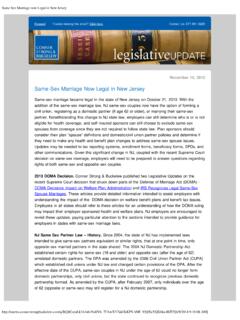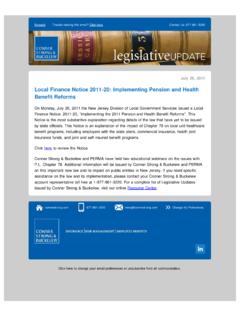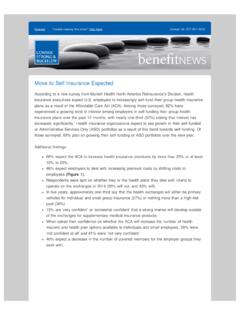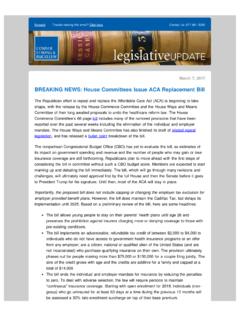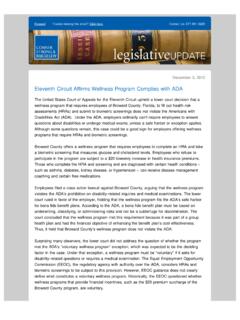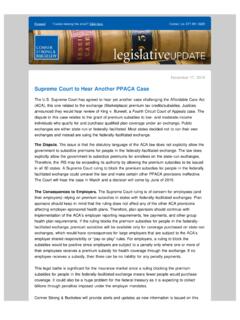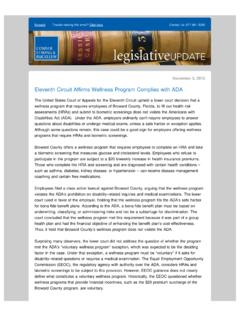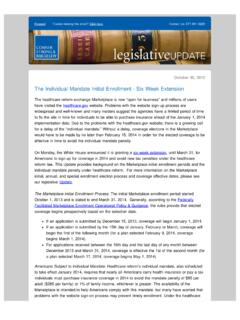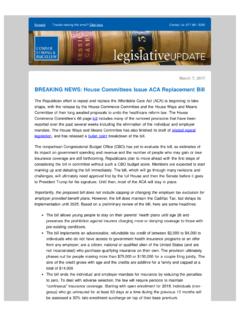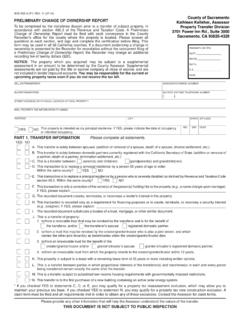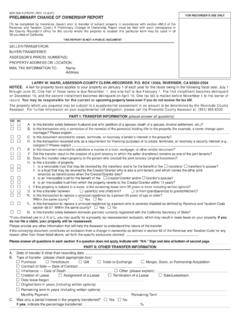Transcription of PCOR Fees - Reporting and Preparation Process
1 PCOR Fees - Reporting and Preparation [6/10/2014 4:08:04 PM]Forward Trouble viewing this email? Click Us: 877-861-3220 June 6, 2013 PCOR Fees - Reporting and Preparation ProcessRecently released guidance addresses the new Patient-Centered Outcomes Research (PCOR)Trust Fund fee that group health plan sponsors will soon face. The total fee liability will depend onhow many arrangements the sponsor offers that will trigger the fee and the method used to countcovered lives. The fee applies to both fully-insured and self-insured plans. Carriers will pay thefee for insured plans so there is nothing additional for a insured plan sponsor to do (other thanpay a higher premium). Self-insured group health plan sponsors are liable for Reporting and payingthe PCOR fee.
2 The following focuses on key aspects of the new guidance applicable to a self-insured plan is the PCOR Fee? The PCOR fee is a fee on issuers of specified health insurance policiesand plan sponsors of applicable self-insured health plans that helps to fund the PCOR Institute will assist, through research, patients, clinicians, purchasers and policy-makers, inmaking informed health decisions by advancing the quality and relevance of evidence-basedmedicine. The Institute will compile and distribute comparative clinical effectiveness Date. The PCOR fee applies to self-insured health plans with plan years ending afterSeptember 30, 2012 and before October 1, 2019. Amount of Fee. The amount of the fee is equal to the average number of lives covered duringthe plan year multiplied by the applicable dollar amount for the year.
3 For plan years ending afterSeptember 30, 2012 and before October 1, 2013, the applicable dollar amount is $1. For planyears ending after September 30, 2013 and before October1, 2014, the applicable dollar amountis $2. For plan years beginning on or after October 1, 2014 and before October 1, 2019, theapplicable dollar amount is further adjusted to reflect inflation in National Health Expenditures, asdetermined by the Secretary of Health and Human Subject to Fee. The fee applies to both fully-insured and self-insured group health the Table of Common Types of Plans for more information on plans that will trigger the PCOR fee does not apply to exempt governmental programs, including Medicare, Medicaid,Children s Health Insurance Program (CHIP) and generally any program established by federal lawfor providing medical care to members of the Armed Forces, veterans and members of certainIndian tribes.
4 Unless a self-insured health plan is an exempt governmental program describedabove, the plan is an applicable self-insured health plan subject to the fee. Thus, the plan sponsorPCOR Fees - Reporting and Preparation [6/10/2014 4:08:04 PM]of a tax-exempt organization or governmental entity self-insured health plan (not otherwise exemptas described above) is responsible for the PCOR fee. Also, self-insured plans that provide only excepted benefits, such as plans that offer benefitslimited to vision or dental benefits and most FSAs, are not subject to the PCOR fee. Further, self-insured plans that are limited to employee assistance programs, disease management programs orwellness programs are not subject to the PCOR fee if these programs do not provide significantbenefits in the nature of medical care or treatment.
5 The PCOR fee also does not apply to policiesand plans that are designed specifically to cover employees who are working and residing outsidethe United Average Number of Lives. The fee is imposed on an applicable self-insured healthplan based on the average number of lives covered under the plan for the plan year. Generally,all individuals who are covered during the plan year must be counted in computing the averagenumber of lives covered for that year. Thus, for example, generally an applicable self-insuredhealth plan must count an employee and his dependent child as two separate covered beneficiaries and retirees or other former employees count as lives covered for thepurpose of calculating the PCOR sponsors of self-insured plans must use one of three alternative methods (1) the actualcount method, (2) the snapshot method or (3) the Form 5500 method to determine the averagenumber of lives covered for a plan year.
6 Plan sponsors may only apply a single method indetermining the average number of lives covered under the plan for the entire plan year. However,a sponsor is not required to use the same method from one plan year to the next. Actual Count Method. Determine the average number of lives covered under the plan forthe plan year by calculating the sum of the lives covered for each day of the plan year anddividing that sum by the number of days in the plan Method. Determine the average number of lives covered under the plan for theplan year by adding the totals of lives covered on a date during the first, second, or thirdmonth in each quarter, or an equal number of dates for each quarter, and dividing the totalby the number of dates on which a count was made.
7 The rules do not require that aspecific date be used for each month or quarter, but do provide specific rules to ensure thatsimilar dates are used each month. In addition, there are two methods within the snapshotmethod to count family members (count the actual number of lives covered on thedesignated date, or count the number of participants with self-only coverage on thedesignated date, plus the number of participants with coverage other than self-onlycoverage on the designated date multiplied by ).Form 5500 Method. Determine the average number of lives covered under a health planfiling for the plan year based on a formula that includes the number of participants actuallyreported on the Form 5500 for the plan year (and only if the Form 5500 is filed no laterthan the due date for the fee imposed for that plan year).
8 Under this method, the totalnumber of lives is determined by simply adding the total participant counts at the beginningand end of the year and dividing by 2 for a plan that only offers single coverage. If a planoffers single coverage along with other coverage ( , family coverage), the total number oflives is determined by adding the total participant counts at the beginning and end of theyear (without dividing by 2).Treatment of Multiple Arrangements. Where an individual is covered by both an insured policyPCOR Fees - Reporting and Preparation [6/10/2014 4:08:04 PM]and applicable self-insured health plan, that individual's life may be counted twice the rule doesnot provide a way to allocate the fee between these separate arrangements.
9 However, the rulesallow the sponsor of a self-insured plan that includes both fully insured and self-insured options todisregard the lives covered solely by the fully insured option. If the same plan sponsor maintainsmore than one arrangement that provides self-insured coverage , if the sponsor maintains anHRA or health FSA in addition to major medical coverage the arrangements can be treated as asingle self-insured health plan if the arrangements have the same plan year for purposes ofcalculating the fee. Similarly, if the sponsor maintains self-insured medical coverage and aseparate self-insured arrangement with the same plan year providing prescription drug benefits,the two arrangements may be treated as one applicable self-insured health plan so that the samelife covered under each arrangement would count as only one covered life under the Pays Fee?
10 The fee for an insured plan is paid by the carrier. The fee for a self-insured planis paid by the plan sponsor, which in most cases means the employer or employee organizationthat established or maintains the plan. The DOL has indicated that these fees generally are notpermissible plan expenses under ERISA, since they are imposed on the plan sponsor and not theplan. This means that plan assets ( , trust assets or participant contributions) should not beused to pay the fee since ERISA s prohibited transaction rules prohibit plan assets from beingused to offset employer obligations. However, multiemployer plan assets may be used to pay thePCOR fees since the plan sponsor liable for a multiemployer plan's fee is generally anindependent joint board of trustees with no source of funding other than plan 720 Reporting .
